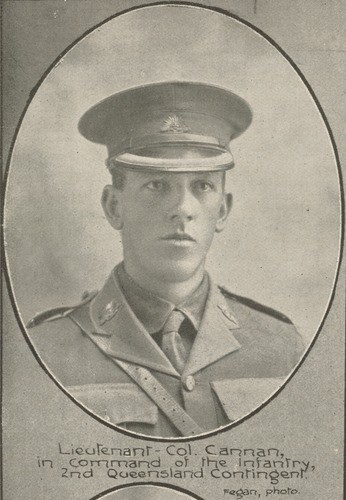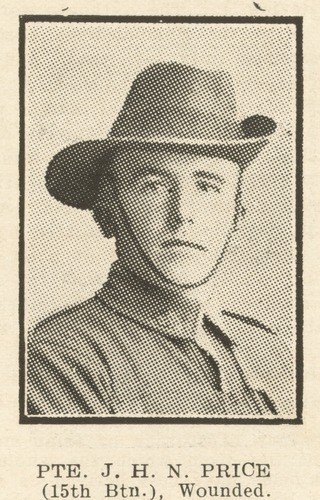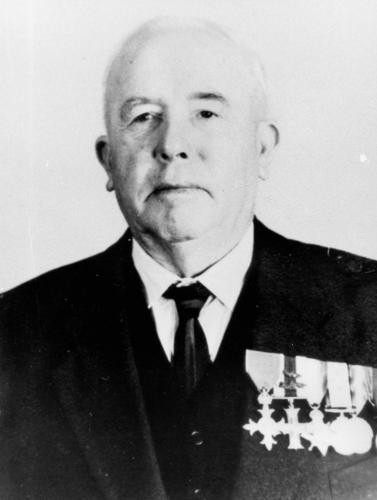James Henry Norman Price of the 15th and 42nd Battalions
By JOL Admin | 17 June 2016

James Henry Norman Price. John Oxley Library, Negative No. 51071.
Guest Blogger: Ian Lang, researcher Sherwood Presbyterian Roll of Honour
Norm Price, as he was known, was the eldest of 8 boys and 3 girls born to Henry John Price and Annie Price of Graceville. Norm was born in 1889 in Heywood, Victoria, however some time around 1905 the family moved to Queensland. Norm was among the first flood of recruits, enlisting on 20th October 1914. He was a 25 year old timber getter, employed in the Canungra area.
Norm joined the 15th Battalion as a private (regimental no. 640) , under the command of Lieutenant Colonel James Cannan who came from a well-known family from Chelmer, Brisbane. Three companies of the 15th Battalion travelled by train to Melbourne, where after more training, they boarded the troopship Borda on the 22nd December 1914 as part of the 4th Brigade. They arrived in Egypt in early February 1915 and began training for the Gallipoli campaign.

Lieutenant-Colonel James Harold Cannan. Queenslander, 12 December 1914, p.24. Record No. 831410.
The 4th Brigade, under the command of Brigadier General John Monash, landed at Anzac Cove late in the afternoon of 25 April and immediately moved up the valley (soon to be named Monash Valley) to the tip of the escarpment, at the position which was later named Quinn's Post after a company commander of the 15th Battalion.

View of Australian soldiers at Quinn's Post, 1915. Australian War Memorial, ID no. A02009.
Quinn’s was a particularly dangerous position as the trenches were close to the drop off into Monash Valley below. The Turkish trenches were extremely close, close enough for bombs to be lobbed with ease. Norm was sniping at Quinn’s Post on the 28th May when a bullet passed through his left shoulder. He was initially transferred to a hospital ship offshore but he was then taken to the #1 Australian General Hospital at Heliopolis outside Cairo. After a period in hospital, and then at a convalescent depot, Norm was sent back to the front, arriving on Gallipoli on 3rd July.

Private James Henry Norman Price. Queenslander, 10 July 1915, p. 28. Record No. 890830.
A major offensive was planned for the beginning of August which involved a number of diversionary assaults at Lone Pine and The Nek, a landing of British Troops at Suvla Bay, and a wide sweep by Australian and New Zealand troops towards the heights. The 15th Battalion was part of the Australian and New Zealand force which was to move north along the Anzac beach at night before turning east up the ridges towards Chunuk Bair and the Sari Bara Ridge. The plan went wrong when commanders relied on Turkish guides to lead them up the narrow gullies. The 15th Battalion suffered severe casualties and the Battalion Commander’s brother, Major Douglas Herman Cannan, was killed in action. Norm Price sustained gunshot wounds to both thighs, probably from a machine gun. He was evacuated to England and, as he was not fit for active service, returned to Australia in November 1915.
Back in Brisbane Norm went before another medical board at Kangaroo Point in January 1916. This report seemed to be more concerned with the shoulder wound sustained back in May 1915 rather than the leg wounds. In spite of the fact that Norm reported some paralysis in his left arm, the board was of the opinion that this could be treated with massage; and passed him as fit for active service. Norm was posted to a reserve battalion at Enoggera.
In May 1916, Norm Price re-enlisted. This time he was drafted as a sergeant cook into the 42nd Battalion (regimental no. 1150). He embarked for the second time on 5th June 1916 and arrived in Southampton in July. The 42nd Battalion was part of the 3rd Division AIF which was in training under the Divisional Commander, now Major General John Monash. The Brigade Commander was Norm’s old battalion commander, now Brigadier James “Bull” Cannan. Norm would have felt right at home.
The 42nd Battalion was deployed to Belgium in December 1916. One month later Norm was promoted to Company Sergeant Major. During the early part of 1917 the battalion rotated in and out of the line around Armentieres and Ploegsteert (soldiers called it Plug Street). In February Norm attended officer’s school and on the 5th March was promoted to 2nd Lieutenant. On 5th June Norm was Mentioned in Despatches. There is no citation for this award in the files and it difficult to determine what the MID was for; it may even relate to earlier actions at Gallipoli. The battalion war diary has no reference.
The Battle of Messines began on the 7th June, with the firing of 19 underground mines and an artillery barrage of over three million shells. On the night of 5/6th June, Norm led a raiding party of some 25 men towards the German lines in order to gather intelligence for the forthcoming offensive. Either in this action, or some event a few days later, Norm received a bullet wound to his hand and finger. He was also gassed and on 9th June was evacuated to a hospital in England where the additional notation of shell shock was added to his file.

Australian soldiers on the road near Petit Pont, behind Hill 63, during the battle of Messines, 7 June 1917. Australian War Memorial, ID number E00607.
For his actions under fire on the 5th and 6th of June, and cool headedness in bringing his men back through an artillery barrage, Norm was recommended by his Brigade Commander for the Military Cross. (Awards for gallantry at this time of the war were closely tied to the British system whereby gallantry awards were determined by rank. Officers of the rank of Colonel and above received the Distinguished Service Order, DSO. Junior officers were awarded the Military Cross, MC. Non commissioned ranks were awarded the Military Medal, MM. In each case the award permitted the recipient to have the appropriate letters after their name). The award was promulgated on 22nd June while Norm was in hospital in England.
While in hospital two significant events occurred. On 28th July Norm was promoted to Lieutenant (probably on the basis of his Military Cross). It would also appear that while in hospital or convalescing Norm met his future wife, Ada Florence Carpenter, of Stamford Hill in London.
In October 1917, Norm went before a medical board where it was determined that he was suffering from gas poisoning and shell shock. The board recommended that he be returned to Australia. Before embarkation Norm and Ada were married, but Ada did not accompany Norm back to Australia.
On 2nd February 1918, Norm Price embarked for overseas service for the third time in Sydney, having recovered sufficiently to be fit for active service. No doubt he also wanted to be closer to his new bride. Manpower in the AIF was at such a critical stage by this time in the war that the authorities would have been willing to take an experienced and decorated officer, even though he might not be fully fit. Norm arrived back in England in March and was posted as an instructor to the School of Musketry at Tidworth. By the first day of August, Norm was back with the 42nd Battalion in France.
The 8th August was the beginning of the end of the German Army in France. The Battle of Amiens was described by Ludendorff (the German field commander in France) as the “blackest day for the German Army”. Norm and the 42nd Battalion were right in the thick of it. After Amiens, the Australians (now fighting as a single corps under Corps Commander Lieutenant-General John Monash) pushed the demoralised enemy back along the Somme, past Mont St Quentin and Peronne, to the remnants of the Hindenburg line. In October 1918 the Australians were spent. Numbers were so low in most battalions that some were disbanded and the survivors sent to make up numbers in the remaining units. Thus it was that Norm was transferred to the 43rd Battalion as the 42nd no longer existed.
Norm went on furlough to London in the middle of October and he was still there when the armistice was signed. There were almost 250,000 Australian servicemen in Europe and Egypt who had to be transported home once the war ended. Not all could be sent home in the first few months and the Army introduced a scheme to allow soldiers to take paid leave in England to further their education and skills for a return to civilian life. Norm was granted six months leave to learn mechanical and electrical engineering from his father-in-law, Mr George Carpenter of Stamford Hill.
Norm, accompanied by his wife, Ada, finally left England in January 1920 and was formally struck off the list of officers in June 1920. Norm and Ada settled at Birkdale, just outside of Brisbane, to be close to Norm’s parents who by this time lived at Redland Bay. The couple had four children.

Norm and Ada Price with their children (left to right) Leonard George, Douglas Norman, Joan Ada, and Gwenyth Alison, 1949. John Oxley Library, Negative No. 51072.
Norm was elected a councillor in the Redlands Shire, in which capacity he served for many years, for some of that time as Shire Chairman. In recognition of his service to the community, Norm Price was awarded an MBE (Member of the Most Excellent Order of the British Empire) in 1961. The John Oxley Library has a photograph of Norm with his medals; MBE, Military Cross, 14/15 Star, Empire medal, Victory Medal with Oak Leaf (Mentioned in Despatches) and the Queen Elizabeth Coronation Medal.

Redland Shire Chairman, James Henry Norman Price. John Oxley Library, Negative No. 51068.
Norm Price died in July 1963 at the age of 74. He is buried at Mount Gravatt Cemetery, Brisbane, in the military section.
Guest Blogger: Ian Lang, researcher Sherwood Presbyterian Roll of Honour
Comments
Your email address will not be published.
We welcome relevant, respectful comments.